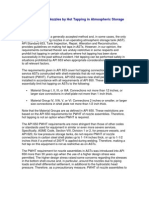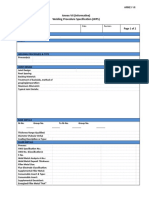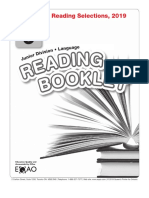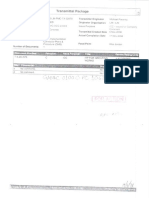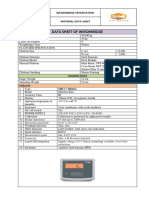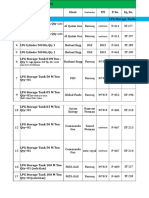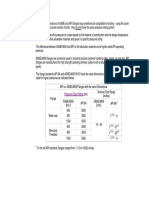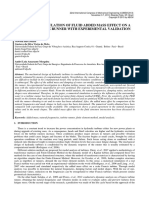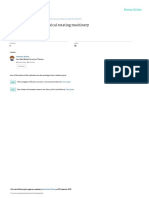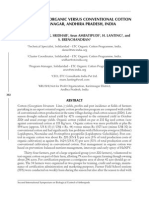Shell Corrosion Allowance For Aboveground Storage Tanks: Debra Tetteh-Wayoe, P.Eng
Shell Corrosion Allowance For Aboveground Storage Tanks: Debra Tetteh-Wayoe, P.Eng
Uploaded by
khabiranCopyright:
Available Formats
Shell Corrosion Allowance For Aboveground Storage Tanks: Debra Tetteh-Wayoe, P.Eng
Shell Corrosion Allowance For Aboveground Storage Tanks: Debra Tetteh-Wayoe, P.Eng
Uploaded by
khabiranOriginal Title
Copyright
Available Formats
Share this document
Did you find this document useful?
Is this content inappropriate?
Copyright:
Available Formats
Shell Corrosion Allowance For Aboveground Storage Tanks: Debra Tetteh-Wayoe, P.Eng
Shell Corrosion Allowance For Aboveground Storage Tanks: Debra Tetteh-Wayoe, P.Eng
Uploaded by
khabiranCopyright:
Available Formats
Proceedings of IPC 2008
International Pipeline Conference
Proceedings of IPC2008
7th3,International
September 29 – October 2008 Pipeline
Calgary, Conference
Alberta, Canada
September 29-October 3, 2008, Calgary, Alberta, Canada
IPC2008-64501
SHELL CORROSION ALLOWANCE FOR ABOVEGROUND STORAGE TANKS
Debra Tetteh-Wayoe, P.Eng.
Enbridge Pipelines Inc.
Edmonton, Alberta, Canada
debra.tetteh-wayoe@enbridge.com
ABSTRACT using API 650 instead of API 653 could be designated as
Enbridge Pipelines Inc. utilizes aboveground crude oil corrosion allowance.
storage tanks for operational flexibility and merchant storage
purposes. Most of these tanks are built in accordance with the This paper will describe the corrosion allowance
requirements of API 650. This standard requires that an calculations in detail as well as address the issue of maximum
appropriate corrosion allowance be included in the minimum allowable design stress.
shell thickness calculations.
INTRODUCTION
A variety of sources were researched in an effort to develop There are more than 400 tanks used in either breakout or
a process that ensures the selected corrosion allowance allows merchant applications across the Enbridge Pipelines system.
for the safe operation of a tank for its entire service life. Some of Breakout is a term used to describe tanks used to relieve surges
these sources include other API standards, historical API 653 on the pipeline and to store product for re-injection and
tank inspection reports, published atmospheric corrosion rates, continued transportation1. Merchant tanks are those used for
and corrosion allowance specifications of industrial long term storage. Most new tanks are built with an expected
counterparts. service life of 25 years, yet almost 40% of Enbridge Pipelines
tanks are more than 50 years old. The oldest of these tanks
Defining an appropriate corrosion allowance requires currently in operation were built in the 1920’s and are located at
consideration of a number of factors: Cushing, Oklahoma.
• Whether or not the product contains significant
sediments and water The tanks on the Enbridge Pipelines system range
• Whether or not an internal lining will be applied in considerably in size: the smallest tanks, 1000 bbls, are used on
accordance with API 652 the feeder pipeline system and the largest, 575000 bbls, are used
• The length of time to the first out-of-service inspection in merchant storage.
• Whether or not the tank will be externally coated
• The temperature of the product stored Regardless of size or application, corrosion is a factor to
• The annual precipitation at the specified location consider in the design of all new tanks. According to the
• The average chloride concentration in rainwater at the Pipeline Performance Tracking System (PPTS) managed by the
specified location American Petroleum Institute (API), releases from aboveground
storage tanks accounted for 5% of all the crude oil releases from
During the course of the corrosion allowance study, the pipeline operating companies between 1999 and 20042. Due to
issue of maximum allowable design stress was also considered. the large volume of product contained, a release from a storage
The allowable stress values specified in the standard for tank has the potential to be catastrophic. The risk associated
construction of new tanks (API 650) differs from the allowable with tank shell corrosion can be mitigated with corrosion
stress values specified in the inspection standard for existing allowance and/or the application of a surface coating.
tanks (API 653). It has been suggested that the incremental
difference between the minimum shell thicknesses calculated
1 Copyright © 2008 by ASME
Downloaded From: https://proceedings.asmedigitalcollection.asme.org on 06/28/2019 Terms of Use: http://www.asme.org/about-asme/terms-of-use
Corrosion affects the shell, bottom, roof and appurtenances maintenance long before they become structurally affected.”3
of above ground storage tanks. The focus of this paper will be Today, however, it is becoming more and more common to see
on the tank shell and will not address the other components in rusted structures as operators are opting for a corrosion
detail. allowance rather than a coating. Figure 2 below shows uniform
corrosion on the exterior of an unpainted tank shell.
NOMENCLATURE
API American Petroleum Institute
bbls Barrels
CA Corrosion Allowance in inches
D Diameter in feet
G Specific Gravity
ft feet
H Height in feet
mils 1/1000 of an inch
mpy mils per year
psi pounds per square inch
Sd Design Stress
St Hydrostatic Stress
td minimum design thickness
tt minimum hydrostatic test thickness
DISCUSSION
TYPES OF SHELL CORROSION Figure 2: Uniform Corrosion on Unpainted Shell Exterior
There are different forms of corrosion to consider when
determining a corrosion rate for an above ground storage tank. Even if the exterior tank is coated, corrosion can occur if the
Figure 1 below illustrates some of the areas that will be coating is not maintained. Figure 3 shows general corrosion on
discussed with respect to tank corrosion. a painted tank.
External Floater Fixed Roof
Unwetted portion Tank Shell
Wind Girder
of shell interior
Vapour
Seal Space
Vapour Pontoon
Space
Product
Pontoon Wall
D-Door
Figure 3: Uniform Corrosion on Painted Shell Exterior
Figure 1: Aboveground Storage Tank Schematic
Pitting is distinctively different than general corrosion and is
Uniform, pitting, vapour space and/or crevice corrosion are all identified by many deep pits in one localized area. It is more
types of corrosion that can occur on both the external and likely to be found on the interior of the tank shell. Figure 4
internal surfaces of the shell. shows pitting found on the interior shell near the D-door of a
tank out of service for an API inspection.
Uniform corrosion, often referred to as general corrosion, is
the most common form of corrosion. Historically this type of
corrosion would not cause major structural problems, because
“structures will normally become unsightly and attract
2 Copyright © 2008 by ASME
Downloaded From: https://proceedings.asmedigitalcollection.asme.org on 06/28/2019 Terms of Use: http://www.asme.org/about-asme/terms-of-use
economical.”4 Sometime a combination of coating and corrosion
allowance is used. That is, a tank is designed with a corrosion
allowance, but a coating is applied to specific areas of concern.
Figure 5 shows an example of exterior coating applied to only
the bottom four feet of the shell:
Figure 4: Pitting on the Shell Interior
Vapour space corrosion is a concern for both external
floating roofs and fixed roof tanks. Typically, only the outside
pontoon wall is affected by vapour space corrosion in external
floating roof applications. Moisture condenses on the tank wall
when there is a significant temperature difference from night to Figure 5: Tank with Minimal External Coating
day. If, however, the roof is stagnant for long periods of time,
such as in merchant tank applications, the tank shell could The product side of the tank shell must also be considered
corrode as well. In fixed roof and internal floating roof when developing a corrosion allowance for the tank shell. The
applications, it is the non-wetted upper portion of the shell that interior surface that is wet by the product is somewhat
is particularly susceptible to vapour space corrosion. protected from moisture by the thin layer of product left on the
wall. The extent of this protection varies with how often the
Crevice corrosion can occur where there is metal to metal tank is cycled (i.e. filled and then emptied), the corrosivity of the
contact. “Many appurtenances such as wind girders and top stored product, and in the case of external floating roofs, the
angle rims are not seal welded but are stitch-welded to the tank. atmospheric conditions. The most aggressive interior corrosion
The formation of rust causes a rust-streaked appearance. occurs in the lower three feet of the shell interior which is in
Sometimes the buildup of corrosion products in the space of the contact with the water that settles out of crude oil products.
crevice can develop sufficient pressure to cause fastener
failures and leaks.”4 One solution to this type of corrosion is to It should be noted that the upper three feet of the interior of
drill holes in the windgirder walkway to allow for water drainage the shell is not typically a surface that is wetted by the liquid
and therefore reduce the amount of mo isture collecting in the and therefore requires the same protection deemed necessary
crevices. for the shell exterior. “This part of the shell does not hold liquid,
but is important to the structural integrity of the tank.” 5
EXTERNAL AND INTERNAL CORROSION
The external corrosion rate, also known as atmospheric MINIMUM SHELL THICKNESS CALCULATIONS
corrosion rate, is highly dependant on the geographical location With respect to tank shell corrosion, the standard
of the tank. The amount of annual precipitation and acidity of governing the design of new above ground storage tanks, API
the precipitation are both factors that contribute to the rate of Standard 650 Welded Steel Tanks for Oil Storage, states the
corrosion. following:
Often an external coating is used on the shell exterior to “The purchaser, after giving consideration to the total effect of
combat atmospheric corrosion. However, a corrosion allowance the liquid stored, the vapor above the liquid, and the
can be used in lieu of coating. With respect to using a coating atmospheric environment, shall specify in the Data Sheet,
Phil Meyers states the following in his text titled Aboveground Tables 1 and 2, any corrosion allowance to be provided for all
Storage Tanks: “When the general corrosion rate is less than 10 components, including each shell courses…” 6
mils/yr, then the addition of the corrosion allowance is often
economical and effective. For higher rates, a coating is most
3 Copyright © 2008 by ASME
Downloaded From: https://proceedings.asmedigitalcollection.asme.org on 06/28/2019 Terms of Use: http://www.asme.org/about-asme/terms-of-use
The purchaser (also referred to as operator) calculates the material is enough for an appropriate corrosion allowance will be
required shell thickness based on “the greater of the design discussed in the next sections.
shell thickness, including any corrosion allowance, or the
hydrostatic test shell thickness.”6 When calculating the design API 353 METHODOLOGY
shell thickness, td, using the product design stress, the net plate The question is: what is the definition of ‘appropriate’ with
thickness (actual less any corrosion allowance) is used in the respect to corrosion allowance? As previously mentioned, the
calculation. standard governing the design of new above ground storage
tanks, API 650, does not provide a specific corrosion rate.
2 .6 D ( H − 1) G There is, however, another API specification that provides
td = + CA (1) guidance with respect to this issue. The scope of API 353,
Sd
Managing Systems Integrity of Terminal and Tank Facilities, is
Whereas, the gross plate thickness (actual) is used for the
“specifically targeted at integrity management of aboveground
calculation of the hydrostatic test thickness, t t.
liquid petroleum storage facilities.”7
2.6 D ( H − 1)
tt = (2) Tank shell leaks due to corrosion are addressed in
Sd Appendix A of API 353. Section 2.3.1.2 describes a step by step
methodology for establishing a base corrosion rate for both
There are some within the industry with the viewpoint that external and internal shell corrosion rates.
if one always uses a specific gravity of water in the design
thickness calculation, there will be an inherent corrosion First the internal corrosion rate is predicted based on the
allowance. The belief is that the difference between the product condition. The products are defined as wet or dry and
thicknesses calculated using a specific gravity of 1.0 versus the assigned a base corrosion rate accordingly. Most of the
specific gravity of the product will be enough to mitigate products stored on the Enbridge Pipelines system contain
corrosion. This may have been valid for the lighter products significant sediments and water, thus would be categorized as
stored in the past. However, today’s crude oil products have wet. The corresponding base corrosion rate for wet product is 5
specific gravities of 0.945 or higher. In many cases, the mils per year (mpy).
variance between the product specific gravity and that of water
is not enough to account for a sufficient corrosion allowance. The next step in calculating the internal corrosion rate is to
The following example uses formula (1) to illustrate this point: determine the internal lining adjustment factor. Since the
Enbridge Pipeline standard specifies that a liner is to be applied
Tank information: in accordance with API 652 (Lining of Aboveground Storage
Diameter = 150 ft Tank Bottoms), the adjustment factor would be 0.5. The reason
Height = 48 ft the application of the liner affects the tank shell corrosion rate is
Specific Gravity = 0.94 because liners applied in accordance with API 652 typically
Plate Specification = 44W extend up the shell wall and hence protect the shell from the
Product Design Stress = 26000 psi water associated with crude oil. The Enbridge Pipelines coating
Hydrostatic Test Stress = 27900 psi specification requires a liner to be applied on at least the lower
24 inches of the interior wall.
2.6 x150 ft ( 48 ft − 1) x 0. 94 The next adjustment factor affecting the internal corrosion
td = + CA rate is the liner age. If an API 653 out-of-service inspection will
26000 psi
be performed between 10 to 20 years of construction, the liner
will be inspected at that time. Therefore, the Lining Age
td = 0 .663 inches + CA Adjustment Factor is 1.0.
If a specific gravity of 1.0 is used in the above equation with no The adjusted internal corrosion rate is the base corrosion
corrosion allowance, td = 0.705 inches. The hydrostatic test rate multiplied by the above two adjustment factors (5 mpy x 0.5
shell thickness, tt, would be 0.657 inches. Since the design shell x 1.0 = 2.5 mpy).
thickness values, using either specific gravity, are greater than
the hydrostatic test thickness values, the design determines the The external base corrosion rate is calculated based on
minimum required shell plate thickness. The difference between climate conditions and the temperature of the product stored.
the design thickness calculated using a specific gravity of 1.0 The majority of the tanks on the Enbridge Pipelines system are
versus 0.94 is only 0.042 inches. Whether or not this amount of not heated. Consequently, the temperature of the product
4 Copyright © 2008 by ASME
Downloaded From: https://proceedings.asmedigitalcollection.asme.org on 06/28/2019 Terms of Use: http://www.asme.org/about-asme/terms-of-use
would fall in the 11-60F category. API 353 separates the type of
climate into the following categories 7:
Marine: locations receiving more than 40 inches of
precipitation per year or having a chloride
concentration in rainwater of at least 1.0 mg /L.
Temperate: locations receiving 20-40 inches of
precipitation per year.
Arid/Dry: locations receiving less than 20 inches of
precipitation per year.
The Enbridge Pipelines system extends across a
considerable portion of North America and hence traverses a
variety of climates. To determine the chloride concentration in
water for a specified location, information supplied by National
Atmospheric Deposition Program and the National Atmospheric
Chemistry Data was used for the US and Canadian locations
respectively. The areas highlighted in orange on Figure 6 show Figure 7: Canadian Annual Mean Total Precipitation9
locations that have notably higher chloride concentration in
rainwater within the US. Once the base external corrosion rate is established, the
Quality of Coating adjustment factor is determined. A lower
adjustment factor will account for the benefits of a quality
external coating. If a high quality coating is used at the time of
construction, then it is assumed there will be no external
corrosion during the first 10 years after coating application. If a
medium quality coating is applied, the assumption is that there
will be no corrosion for the first 5 years of service. Predictably,
if the quality of coating is low or there is no coating, no credit is
given. The adjustment factor is calculated by dividing the
number of years the tank will be unprotected by the tank age.
The classification difference between high versus medium
quality coating is somewhat subjective. The operator has to
make a judgment as to whether or not it is reasonable to assume
there will be no external corrosion for the specified time period
in the chosen category. At the time that the photo in Figure 8
was taken, the external coating has failed and external corrosion
is occurring. If a coating is allowed to degrade to this point, no
Figure 6: US Map of Chloride Concentration in Rainwater8 credit should be given to the adjustment factor:
Annual rainfall maps, such as the one shown in Figure 7,
can be used to determine the amount of precipitation per year
for various locations. The areas on this diagram that are
highlighted in green and blue can be expected to receive more
than 40 inches of precipitation per year. The areas highlighted
in orange and red are likely to receive less than 20 inches of
precipitation per year. This type of information is available from
various sources, including the National Climate Data Centre in
the US and the National Atmospheric Chemistry Database in
Canada.
5 Copyright © 2008 by ASME
Downloaded From: https://proceedings.asmedigitalcollection.asme.org on 06/28/2019 Terms of Use: http://www.asme.org/about-asme/terms-of-use
The above mentioned API 353 standard states that a “user
is encouraged to adopt established corrosion rates developed
from tank inspections when available.”7 One of the
disadvantages associated with using historical inspection
reports is that the recorded original thickness of the material is
often the nominal thickness and not the actual thickness. A
significant number of historical inspection reports that Enbridge
has on file show an average measured shell plate thickness
(after many years of service) greater than the original thickness.
In some cases, even the minimum measured thickness value is
higher than the original thickness. Thus, a corrosion rate
calculated using the nominal thickness as the original thickness
will be inaccurate.
Another problem with basing corrosion allowance solely on
historical inspection reports is that corrosion rates vary
Figure 8: Coating Failure substantially from tank to tank despite similar service
applications. If the maximum corrosion rate at a specified
The combined corrosion rate (external and internal) is location storing crude oil is 2.5 mpy, the average is 0.75 mpy and
calculated once the operator decides, based on past experience, median value is 0.50 mpy, it is difficult to determine which of
whether the internal corrosion is likely to be widespread or these values should be used to estimate an appropriate
pitting. “If the internal corrosion is widespread, the corrosion corrosion rate on a new tank.
areas will likely overlap such that the shell thickness is
simultaneously reduced both internal and external influences.” 7 Lastly, the accuracy of the thickness measurements has to
Therefore, if internal corrosion is widespread, the internal and be considered when reviewing historical inspection reports.
external corrosion rates are added. In the case of internal Typically the measurements are a sample of each plate and not a
pitting, it is unlikely that it will combine with external corrosion scan of the entire plate. The recorded value is only the minimum
to create substantial shell wall loss. In this case, the greater of thickness of the measurement taken and not necessarily the true
the internal and external corrosion rate is used to calculate minimum thickness of that particular plate. The thickness
corrosion allowance. It is noted in API 353 that the “combined measurement can also be affected by the paint thickness if the
corrosion rate should not be set lower than 2 mils per year.” 7 exterior of the tank is coated.
An unpainted Enbridge Pipeline crude oil tank built in the Nonetheless, historical inspection reports are useful for
Edmonton, Alberta area with a liner installed as per API 652 comparison purposes. The corrosion rates calculated using the
would have a base external corrosion rate of 1.0 mpy. An API 353 methodology discussed above were comparable to the
adjustment factor would not be applied since it is an unpainted corrosion rates calculated from historical inspection reports.
tank. The internal corrosion rate would be 2.5 mpy. Based on The comparison gives a sense as to whether or not the
past inspections, the most likely type of internal corrosion is predicted corrosion rates are reasonable. For example, the
pitting. Hence, the combined corrosion rate would be the greater previously mentioned tank to be built in the Edmonton area
of the two corrosion rates. Using a 25 year service life, the would have an expected corrosion rate of 2.5 mpy according to
corrosion allowance specified for this tank would be 0.0625 the API 353 methodology. The corrosion rates for the 22 tanks
inches (2.5 mpy x 25 yrs). sampled at the Enbridge Pipelines Edmonton facility ranged
from 0 to 2.3 mpy, with an average of 1.3 mpy. The 2.5 mpy
A corrosion allowance of 0.0625 inches, as determined estimated using the API 353 method is higher than these
using the API 353 methodology, can now be compared to the historical values, yet still within reason considering the
value illustrated in the example from the Minimum Shell corrosion rate determined using historical inspection is
Thickness Calculation section of this paper. The difference, potentially underestimated.
0.042 inches, between the thicknesses calculated using specific
gravity water versus product would not be as much as the PUBLISHED CORROSION RATES
corrosion allowance deemed ‘appropriate’ according to API 353. There are a few sources for published corrosion rates.
Table 1 below is an excerpt from the Atmospheric Corrosion
Technology Laboratory section of the Kennedy Space Centre
website10. Table 1 shows the corrosion rate of carbon steel at
HISTORICAL API 653 INSPECTION REPORTS various locations:
6 Copyright © 2008 by ASME
Downloaded From: https://proceedings.asmedigitalcollection.asme.org on 06/28/2019 Terms of Use: http://www.asme.org/about-asme/terms-of-use
API 650 VERSUS API 653 DESIGN STRESS VALUES
Table 1: Atmospheric Corrosion Rates – Kennedy Space Lastly, the difference between the design stress values
Center specified in API 650 Welded Steel Tanks for Oil Storage versus
Location Type of Corrosion API 653 Tank Inspection, Repair, Alteration, and Reconstruction
Environment Rate (mpy) will be addressed. It is common practice to use 25 years as the
Esquimalt, BC Rural Marine 0.5 service life of a new tank. Although many tanks are operated
Pittsburgh, PA Industrial 1.2 beyond 25 years, the minimum remaining wall thickness
Cleveland, OH Industrial 1.5 measured at the specified inspection interval is usually
Limon Bay, Panama, CZ Tropical Marine 2.4 acceptable. Sometimes this is because the rate of corrosion is
East Chicago, IL Industrial 3.3 not as high as expected. More often, the reason there is more
Brazos River, TX Industrial Marine 3.7 than enough remaining wall thickness on the older tanks is
Daytona Beach, FL Marine 11.6 because the allowable product design stress values specified in
Pont Reyes, CA Marine 19.7 API 653 are higher than those in API 650.
Kure Beach, NC Marine 21
It has been suggested that the design stress values of API 653
Caleta Point Beach, Panama, CZ Marine 27
be used for the minimum shell thickness rather than those of
Kennedy Space Center, FL Marine 42
API 650. The minimum required shell thickness calculated using
design stress values specified in API 653 versus API 650 is
Additional published corrosion rates can be found in significantly lower, as shown below:
Corrosion Control by Samuel Bradford 11. This publication lists
a substantially lower corrosion rate for carbon steel in an Example: A tank 150 feet in diameter, 48 feet in height, storing
industrial atmosphere: between 0.4 and 0.9 mpy. product with a specific gravity of 0.90, made of 44W material
(API 653 design stress =28 000 psi, API 650 design stress = 26
Uhlig’s Corrosion Handbook is yet another source for 000 psi)
atmospheric corrosion rate. Table 2 shows the range in
2.6 x150 ft ( 48 ft − 1) x0.90
corrosion rates extrapolated from the information presented in API 6536: td = = 0.589 inches
this text 12. 28000 psi
Table 2: Atmospheric Corrosion Rates – Uhlig’s 2.6 x150 ft ( 48 ft − 1) x0.90
API 65013: td = = 0. 635inches
Location Corrosion Rate (mpy) 26000 psi
Industrial 0.3 - 1.3
Rural 0.8 - 2.0 The above example shows that the difference between the
Marine 0.1 - 0.5 minimum thicknesses calculated using API 650 versus API 653
design stresses (0.635 inches - 0.589 inches = 0.046 inches) is
not quite as much as a specified corrosion allowance of 0.0625
One should be able to look up a specific location and find
inches. Even if the difference was 0.0625 inches, this variance
the published corrosion rate. The problem is, as illustrated with
can not be used for corrosion allowance in new construction
the sources provided above, the information is inconsistent.
applications.
Within the industrial category, the corrosion rates of the three
publications range from 0.3 to 3.3 mpy. Based on a 25 year The allowable design stress values specified by API 650 are
service life, the calculated corrosion allowance would range lower than API 653 for a reason. There is a safety factor built
from 0.0075 inches to 0.0825 inches. into the API 650 allowable design stress values based on the
fact that the actual corrosion rate in not known until the tank
INDUSTRIAL COUNTERPARTS has been in service. Assumptions can be made about corrosion
In addition to historical inspection reports, specifications of rates based on similar service, but the actual corrosion rates can
our industrial counterparts were reviewed as another not be determined until shell thickness measurements are taken
reasonability check of the corrosion rates calculated using API after that tank has been in service for a significant period of
353. Two major petroleum companies shared their tank design time. At the first required API 653 in-service inspection, five
specifications and both use a tank shell corrosion allowance of years after commissioning, the thickness measurements are
0.0625 inches unless otherwise specified by the project. One of taken and compared to the minimum required thickness based
the companies noted that additional corrosion allowance would on the API 653 stress values.
be considered for coastal locations. Their specified corrosion
Another possible reason the API 653 allowable stress
allowances are in accordance with the value determined using
values are higher than those at the time of construction is that
API 353 methodology.
most of the atmospheric corrosion is likely to occur in the first
five years of service. Typically, atmospheric corrosion is not
7 Copyright © 2008 by ASME
Downloaded From: https://proceedings.asmedigitalcollection.asme.org on 06/28/2019 Terms of Use: http://www.asme.org/about-asme/terms-of-use
linear with time. “The build up of corrosion products often REFERENCES
tends to reduce the corrosion rate over time.” 8 The specified 1. Department of Transportation Title 49 Transportation
corrosion allowance is based on the average expected corrosion Chapter I - Pipeline and Hazardous Materials Safety
rate. It is possible that the corrosion rate in the first five years of Administration, Part 195.2
service may be higher than it would be over the lifetime of the 2. American Petroleum Institute, PPTS Operator Advisory
tank. The safety factor of the lower API 650 design stress 2006-4: Crude Oil Releases, 1999-2004
values would take this into account. After five years of service, 3. NASA Kennedy Space Centre Corrosion Technology
the tank can be evaluated with the higher API 653 stress values Laboratory Website
since the corrosion rate is expected to level off. http://corrosion.ksc.nasa.gov/unifcor.htm
4. Myers Philip E., 1997, Aboveground Storage Tanks,
McGraw-Hill
CONCLUSION
5. Educational Program Innovations Center Course
Upon review of various information sources, the Enbridge
Material, Above Ground Storage Tanks, October 19-20,
corrosion allowance specification was developed using the API
2006
353 methodology. The design specifications from a few of our
6. Welded Steel Tanks for Oil Storage, API Publication
industrial counterparts reinforced the decision to use this
650 Eleventh Edition, May 2007
methodology. Moreover, published data and historical
7. Managing Systems Integrity of Terminal and Tank
inspection reports both provide too large a range in corrosion
Facilities. API Publication 353 First Edition, November
rates to be used effectively. An additional benefit to using the
2006
API 353 methodology is that it provides a consistent approach
8. National Atmospheric Deposition Program (NAPD)
for new construction locations where historical inspection
Website
information is yet to exist.
http://nadp.sws.uiuc.edu/isopleths/maps2000/cl.pdf
9. Atlas of Canada Website
It was also noted over the course of this investigation that
http://atlas.nrcan.gc.ca/site/english/maps/environment
it is not correct to assume the design stress values specified in
/climate/precipitation/precip
API 653 can be used for new construction shell thickness
10. NASA Kennedy Space Centre Corrosion Technology
calculations. API 12C, Welded Storage Tank Specification, the
Laboratory Website
predecessor to API 650, was published in 1936. The current
http://corrosion.ksc.nasa.gov/atmos.htm
version of API 650 represents over 70 years of experience. The
11. Bradford Samuel A, 1993, Corrosion Control, Van
developers of both API 650 and 653 have extensive experience
Nostrand Reinhold
in tank design and deliberately specify different design stress
12. Revie R. Winston, 2000, Uhlig’s Corrosion Handbook
values.
Second Edition, John Wiley & Sons.
13. Tank Inspection, Repair, Alteration, and
ACKNOWLEDGMENTS
Reconstruction, API Publication 653 Third Edition,
Dean Thieson C.E.T. Enbridge Pipelines Inc.
December 2001, Addendum 1, September 2003
8 Copyright © 2008 by ASME
Downloaded From: https://proceedings.asmedigitalcollection.asme.org on 06/28/2019 Terms of Use: http://www.asme.org/about-asme/terms-of-use
You might also like
- Skin Effect Heat Tracing SpecDocument10 pagesSkin Effect Heat Tracing SpecSaraswatapalitNo ratings yet
- Basis of Design - Pig Launcher & ReceiverDocument9 pagesBasis of Design - Pig Launcher & ReceiverAndreas Schlager100% (5)
- 5 Form Test Piping Package Data SheetDocument1 page5 Form Test Piping Package Data Sheetmashudi_fikriNo ratings yet
- ENVI Met TutorialDocument45 pagesENVI Met TutorialOliveiro Alvarado75% (8)
- Ivan Antić-Samadhi-Unity of Consciousness and ExistenceDocument141 pagesIvan Antić-Samadhi-Unity of Consciousness and ExistenceDanijel Bajić100% (1)
- Approved Tank Hydrostatic Test Procedure - Rev.FDocument28 pagesApproved Tank Hydrostatic Test Procedure - Rev.Fimran0% (1)
- Data Sheet Air Foam ChamberDocument1 pageData Sheet Air Foam ChamberPinjala AnoopNo ratings yet
- 2.vendor Print Index & ScheduleDocument3 pages2.vendor Print Index & ScheduleChatree Taweekong100% (2)
- API 650 Tank Construction Sequence PDF - Google SearchDocument3 pagesAPI 650 Tank Construction Sequence PDF - Google SearchSunket Patel100% (1)
- Preservation by NitrogenDocument3 pagesPreservation by NitrogenHesham badawy67% (3)
- Electrode Test Record E6010Document9 pagesElectrode Test Record E6010Veeraraghavan GuruNo ratings yet
- Tanks - Addition of Shell Nozzles by Hot TappingDocument2 pagesTanks - Addition of Shell Nozzles by Hot TappingJuan DelacruzNo ratings yet
- Welding Procedure Specification (WPS) FormDocument2 pagesWelding Procedure Specification (WPS) FormEarl Harbert0% (2)
- Marine Safety Management Plan: Kendall Bay Sediment Remediation ProjectDocument37 pagesMarine Safety Management Plan: Kendall Bay Sediment Remediation Projectkhabiran100% (1)
- G6 Reading BKLT 2019 PDFDocument5 pagesG6 Reading BKLT 2019 PDFMG JacobNo ratings yet
- Dark Void (Official Prima Guide)Document161 pagesDark Void (Official Prima Guide)mikel4carbajoNo ratings yet
- Linearity, Repeatability & Steady State Accuracy Api-675Document1 pageLinearity, Repeatability & Steady State Accuracy Api-675Parth ThakarNo ratings yet
- Section 712-Mechanical-Commissioning Spare Part Rev.0 PDFDocument2 pagesSection 712-Mechanical-Commissioning Spare Part Rev.0 PDFKari SmithNo ratings yet
- Customer Name Date Bid Due Date: Sweco Fab Inc. Customer RFQ FormDocument2 pagesCustomer Name Date Bid Due Date: Sweco Fab Inc. Customer RFQ FormGustavo GarciaNo ratings yet
- Blind Flange Thickness CalculationDocument3 pagesBlind Flange Thickness CalculationAnonymous waSxJGoNo ratings yet
- Tpp-Abe-Mp-1201-0004 - Data Sheet For Pig Launcher & Receiver - R2 - 13-May-2016Document9 pagesTpp-Abe-Mp-1201-0004 - Data Sheet For Pig Launcher & Receiver - R2 - 13-May-2016OlusayoNo ratings yet
- SP 1212 Check SheetDocument5 pagesSP 1212 Check SheetDaniel Martinez100% (1)
- Draw Off Sump PDFDocument2 pagesDraw Off Sump PDFpradeep4545No ratings yet
- (API 610-10th) Centrifugal Pump - SI UnitsDocument2 pages(API 610-10th) Centrifugal Pump - SI UnitsParaschiv AlexandruNo ratings yet
- Ametank 10.9 Releases Notes.: If You Have Any Questions Please ContactDocument8 pagesAmetank 10.9 Releases Notes.: If You Have Any Questions Please ContactvikramNo ratings yet
- Vendor: Design Information: Gas BootDocument2 pagesVendor: Design Information: Gas Boot124swadeshiNo ratings yet
- Pttep Painitng of Offshore FacilitiesDocument66 pagesPttep Painitng of Offshore FacilitiesSufianNo ratings yet
- R1111-DSH-PL-00-021 - DATA SHEET FOR PIG LAUNCHER-Rev 0ADocument4 pagesR1111-DSH-PL-00-021 - DATA SHEET FOR PIG LAUNCHER-Rev 0AAHMED AMIRANo ratings yet
- 024 Itp For Grouting Works PDFDocument8 pages024 Itp For Grouting Works PDFHarshvardhan PathakNo ratings yet
- Bolt-Gfs Tank CatlogueDocument13 pagesBolt-Gfs Tank CatlogueSALES IQWATERNo ratings yet
- Method Statement For CPFII Pipe Cleaning&Flushing With Air Works Rev1Document9 pagesMethod Statement For CPFII Pipe Cleaning&Flushing With Air Works Rev1Delil OzanNo ratings yet
- API 650 Tank Design CalculationDocument8 pagesAPI 650 Tank Design CalculationHoracio RodriguezNo ratings yet
- Engineering Group: Kuwait Oil Company (K.S.C.)Document14 pagesEngineering Group: Kuwait Oil Company (K.S.C.)Aravindan Ganesh KumarNo ratings yet
- 3600 - Hi-Lo Pilot SwitchDocument10 pages3600 - Hi-Lo Pilot Switchsumesh19778933No ratings yet
- Tie in PointsDocument1 pageTie in Pointsrenjithv_4No ratings yet
- Data Sheet WB RU VDocument5 pagesData Sheet WB RU VMaharani Putri IndrianurNo ratings yet
- LPG Storage Tanks LPG Tank 100 M Ton Qty LPG Tank 100 M Ton QtyDocument69 pagesLPG Storage Tanks LPG Tank 100 M Ton Qty LPG Tank 100 M Ton QtyIqra AngelsNo ratings yet
- Min. Nozzles Spacing API-650Document1 pageMin. Nozzles Spacing API-650jojo_323No ratings yet
- GRP Bonding ProcedureDocument19 pagesGRP Bonding Proceduremahi1437100% (2)
- Mto TankDocument1 pageMto TankHarun Al-Rasyid100% (1)
- 45 KL Oil Storage Tank V-102: Mechanical Data Sheet For VesselDocument4 pages45 KL Oil Storage Tank V-102: Mechanical Data Sheet For VesselKrunalNo ratings yet
- Asme B31Document3 pagesAsme B31mohd as shahiddin jafriNo ratings yet
- 6 77 0001 Rev - 4 PDFDocument40 pages6 77 0001 Rev - 4 PDFRam Kadam0% (1)
- Comparing API and ASME-ANSI Flanges Dimensions and Pressure RatingsDocument2 pagesComparing API and ASME-ANSI Flanges Dimensions and Pressure Ratingsjorge1952100% (1)
- Welding Procedure For Plate - WPSDocument1 pageWelding Procedure For Plate - WPSCristian ZidarescuNo ratings yet
- API 650 RF Pad Calculation PDFDocument1 pageAPI 650 RF Pad Calculation PDFRakeshNo ratings yet
- LNG Centrifugal Compressors BrochureDocument12 pagesLNG Centrifugal Compressors BrochurehacenescribdNo ratings yet
- Sample MRB Index For ENIDocument1 pageSample MRB Index For ENIAnanthu Krishnan100% (1)
- Data Sheet For Barred Tee 010719Document1 pageData Sheet For Barred Tee 010719Heru Agung Setyanto100% (1)
- Plumbness Inspection ReportDocument3 pagesPlumbness Inspection ReportDoris DorisNo ratings yet
- Data Sheet Polyken 980 & 955Document4 pagesData Sheet Polyken 980 & 955Teguh SilaNo ratings yet
- Erection Sequence of LNG TankDocument29 pagesErection Sequence of LNG TankIshack MohammedNo ratings yet
- Cathodic Protection BOMDocument4 pagesCathodic Protection BOManonymous542No ratings yet
- EGP3-10.00 Storage TanksDocument53 pagesEGP3-10.00 Storage TanksMathias Onosemuode100% (1)
- Rolling LadderDocument2 pagesRolling LadderSarwar KhanNo ratings yet
- Hydro-Test Manifold 1Document1 pageHydro-Test Manifold 1ryan gumanitNo ratings yet
- API Terminals FeatureDocument2 pagesAPI Terminals FeatureIndunil WarnasooriyaNo ratings yet
- Spe 189932 MsDocument10 pagesSpe 189932 MsRenzo LópezNo ratings yet
- 5 PDFDocument12 pages5 PDFmanojNo ratings yet
- Infill Liner PipelineDocument12 pagesInfill Liner PipelineKhairul AshrafNo ratings yet
- Floating Pan For Storage TanksDocument4 pagesFloating Pan For Storage TanksIndunil Prasanna Bandara WarnasooriyaNo ratings yet
- Investigation of Casing Connection Failure Mechanisms in Thermal WellsDocument8 pagesInvestigation of Casing Connection Failure Mechanisms in Thermal WellsEngelbert MorenoNo ratings yet
- Design and Development of A 10 Million Liters Capacity Petroleum Product Storage TankDocument13 pagesDesign and Development of A 10 Million Liters Capacity Petroleum Product Storage TankSuit ChetriNo ratings yet
- API 650 & API 653 TrainingDocument56 pagesAPI 650 & API 653 TrainingSalah JallaliNo ratings yet
- Api 610Document11 pagesApi 610prakasharmyNo ratings yet
- Customer Value Chain Analysis For Sustainable Reverse Logistics Implementation: Indonesian Mobile Phone IndustryDocument4 pagesCustomer Value Chain Analysis For Sustainable Reverse Logistics Implementation: Indonesian Mobile Phone IndustrykhabiranNo ratings yet
- CapmDocument3 pagesCapmkhabiranNo ratings yet
- No. F-14-AAA-0000Document9 pagesNo. F-14-AAA-0000khabiranNo ratings yet
- Average Fuel ConsumptionDocument1 pageAverage Fuel ConsumptionkhabiranNo ratings yet
- Orcaflex Standard Training Course Syllabus: Line TypesDocument3 pagesOrcaflex Standard Training Course Syllabus: Line TypeskhabiranNo ratings yet
- Nonlinear Analysis of Offshore Structures: Bjo RN Skallerud Jo Rgen AmdahlDocument1 pageNonlinear Analysis of Offshore Structures: Bjo RN Skallerud Jo Rgen AmdahlkhabiranNo ratings yet
- Numerical Simulation of Fluid Added Mass Effect On A Kaplan Turbine Runner With Experimental ValidationDocument9 pagesNumerical Simulation of Fluid Added Mass Effect On A Kaplan Turbine Runner With Experimental ValidationkhabiranNo ratings yet
- MSC Guidelines For The Review of Miscellaneous Barge StabilityDocument4 pagesMSC Guidelines For The Review of Miscellaneous Barge StabilitykhabiranNo ratings yet
- Professor Jørgen Amdahl: EducationDocument2 pagesProfessor Jørgen Amdahl: EducationkhabiranNo ratings yet
- Cigdem Avci-Karatas EurasianSciEnTech2020Document11 pagesCigdem Avci-Karatas EurasianSciEnTech2020khabiranNo ratings yet
- Thin-Walled Structures: R.M.F. Paulo, F. Teixeira-Dias, R.A.F. ValenteDocument3 pagesThin-Walled Structures: R.M.F. Paulo, F. Teixeira-Dias, R.A.F. ValentekhabiranNo ratings yet
- API Standards For Mechanical Rotating Machinery: September 2020Document4 pagesAPI Standards For Mechanical Rotating Machinery: September 2020khabiranNo ratings yet
- The Poseidon Principles Faqs: Background 3Document12 pagesThe Poseidon Principles Faqs: Background 3khabiranNo ratings yet
- Post Covid 19 Market TrendsDocument40 pagesPost Covid 19 Market TrendsKaran Ojha100% (1)
- Bca SyllabusDocument55 pagesBca Syllabusapi-349492533No ratings yet
- GMP Implementation and CCP Determination On ChocolDocument10 pagesGMP Implementation and CCP Determination On ChocolFuji KusumaNo ratings yet
- IRigBlueBoardApp Iphone User ManualDocument12 pagesIRigBlueBoardApp Iphone User ManualfedoerigoNo ratings yet
- Leakage Detection Using Fiber Optics Distributed Temperature MonitoringDocument8 pagesLeakage Detection Using Fiber Optics Distributed Temperature MonitoringeochiufpicNo ratings yet
- Case Study On Organic Versus Conventional Cotton in Karimnagar, Andhira Pradesh, IndiaDocument16 pagesCase Study On Organic Versus Conventional Cotton in Karimnagar, Andhira Pradesh, IndiaNainar ReddyNo ratings yet
- Problem of UnfruitfulnessDocument6 pagesProblem of UnfruitfulnessRockyNo ratings yet
- RAC Lecture 3 Applications of Refrigeration Air ConditioningDocument20 pagesRAC Lecture 3 Applications of Refrigeration Air ConditioningBryan ScofieldNo ratings yet
- Zoology+Lecturer+Past+Papers+ MergedDocument30 pagesZoology+Lecturer+Past+Papers+ MergedDarshana WaghaniNo ratings yet
- Non Peza ClientsDocument15 pagesNon Peza ClientsDioscoro J. Jebulan100% (1)
- A ReviewDocument17 pagesA ReviewkanomasiNo ratings yet
- Skandhy, Dathus, AyatanasDocument2 pagesSkandhy, Dathus, AyatanasdrubtobNo ratings yet
- ESC102 CH 5Document73 pagesESC102 CH 5EMJAYNo ratings yet
- Alternative Medicine in BelizeDocument5 pagesAlternative Medicine in BelizeMyaW731No ratings yet
- Nitrosaminas em Preservativos e BalõesDocument4 pagesNitrosaminas em Preservativos e BalõeseveltoncNo ratings yet
- 2GC4Document7 pages2GC4ddddddddeNo ratings yet
- Earth Sci Initial Release June 14 PDFDocument170 pagesEarth Sci Initial Release June 14 PDFJesha mae MagnoNo ratings yet
- Bestolife® 4010® NMDocument2 pagesBestolife® 4010® NMJorge ForeroNo ratings yet
- 1.timing Optimization Techniques: 1. MappingDocument152 pages1.timing Optimization Techniques: 1. MappingPraveen Kumar100% (1)
- Samsung Galaxy A11 A115F@smeleronics-CopiarDocument22 pagesSamsung Galaxy A11 A115F@smeleronics-CopiarErnesto minoNo ratings yet
- Invoice AbitamaHydro 06021Document1 pageInvoice AbitamaHydro 06021RomyNo ratings yet
- Data Sheets - HP Series 242kV/40kA - 2000ADocument4 pagesData Sheets - HP Series 242kV/40kA - 2000Ajurica_2006No ratings yet
- XS618B1PAL2 DataSheetDocument2 pagesXS618B1PAL2 DataSheetRAUL ORTIZNo ratings yet
- 1002 GPS Approaches Dissected PDFDocument3 pages1002 GPS Approaches Dissected PDFMos DetNo ratings yet
- 38007111M PDFDocument95 pages38007111M PDFPak NdutNo ratings yet
- Article - The Game Plan For Aligning The Organization - Kelley School of BusinessDocument13 pagesArticle - The Game Plan For Aligning The Organization - Kelley School of BusinessTONI EBERT HUALI VILLANo ratings yet











